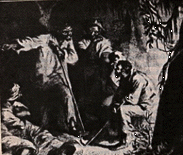
Nat Turner


Depiction of Nat Turner
planning his famed revolt.
| In the same year that Gabriel died and Vesey gained his freedom, a young boy was born to an African-born slave. Not able to bear the idea of bringing a "slave" into the world, she had to be stopped from killing her new-born son. She took her inablity to kill him as a sign that he was destined for something greater. Little did she realize that for decades to come, the very mention of her son's name would inspire fear, fascination and awe: Nat Turner. |
|
Early in life Turner came to believe that God had set him apart for some great purpose. With this in mind, he stayed mostly to himself and devoted his time to fasting and prayer. Something of a child prodigy on the slave plantations of Southampton County, Virginia, Turner was much respected by the time he reached maturity. Fellow slaves looked to him for advice and there is even an incident of him baptizing a white overseer. A mystic and heavily religous man, Turner had daily visions. He saw drops of blood on the crops and hieroglyphs on the leaves. One day he saw Black and white spirits wrestling in the sky; the sun grew dark and blood gushed forth in streams. A spirit spoke to him, fortelling that at the appearance of a sign he should slay his enemies with their own weapons. |
| Turner's sign came in the form of a solar eclipse in February, 1831. Choosing several disciples, Henry Porter, Hark Travis, Nelson Williams and Samuel Francis, Turner made plans to attack on July 4. He became ill however and was forced to delay his plans. Then on August 13 another sign came in which the sun turned a bluish-green. Turner now set the date of Sunday, August 21 for his insurrection. As he met to plan his course of attack, Nat was introduced to two more disciples. One of them was a six-foot, well devolped slave with whip scars lining his back named Will. Reputed to be the strongest man in the county, he bore a special grudge; his wife had been sold by his master. His handling of a broad-ax was so well that Nat would later dub him, "Will the Executioner." |
|
Starting at about one o'clock in the morning and continuing through the day of August 22, Turner and his band cut a swath of red through Virginia attempting to reach the Southampton town of Jerusalem. Moving swiftly, the growing band of about 60 rebels chopped down old, young, male, female, and child alike. No one with a white skin was spared except a family of poor whites who owned no slaves. All together, at least 57 whites were killed. Turner's revolt turned Southampton on its ear. Panic gripped the region as men, women and children ran to the swamps, barricaded themselves in public buildings, or fled the state. Late in the evening of August 22, Turner and his disciples were attacked by a group of twenty or so armed whites. Turner counterattacked and the whites fled. Giving chase, the slaves however found a larger group waiting for them. Though without fatalities, the rebel group became disorganized and a succeeding false alarm reduced their number to 20. After another skirmish, Turner's group became disassembled and the rebel leader was forced to find hiding. |
| By this time thousands of federal troops were converging on the area from all directions. For the two months that Turner eluded capture, Black slaves were massacred by panic-stricken whites who suspected them all of insurrection. The panic was so great it spread to neighboring states. In North Carolina, after a boy rode into the town with false news of a group of slaves on the march, the city of Murfreesboro went into uproar. People fled the town, women barricaded themselves in buildings, and an old man keeled over and died. When Turner was finally captured on October 30, 1831, guns were fired all over Southampton County. Thinking this sound to be a sign of another rebellion, many Southamptons fled to the swamps, misinterpreting the cry, "Nat is caught!" for "Nat is coming!" Turner was taken to his Jerusalem in chains. At his trial he pleaded not guilty, stating that he "did not feel guilty." On November 11, 1831 this Black martyr and freedom fighter was executed by hanging. 'Old Nat's War,' as many Blacks in Southampton called the revolt, would be remembered for decades to come and forever shatter the myth of the docile slave. (Photo and Information courtesy of Before the Mayflower and Fires of Jubilee) |



